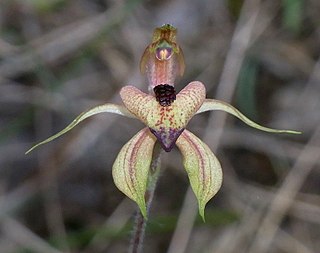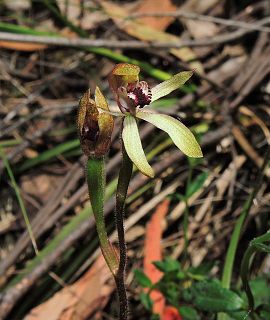Caladenia tonellii, commonly known as robust fingers, is a species of orchid endemic to Tasmania. It has a single, long, erect, hairy leaf and up to three bright pink flowers with brownish backs. It is a rare orchid which exists in low numbers.

Caladenia carnea, commonly known as pink fingers, is a plant in the orchid family Orchidaceae and is endemic to eastern and south-eastern Australia, including Tasmania. It has a single thin, green leaf and one to five white or pink flowers with red stripes and two rows of yellow-tipped "calli" on their labellum.
Caladenia argocalla, commonly known as white beauty spider orchid, is a plant in the orchid family Orchidaceae and is endemic to South Australia. It is a ground orchid which grows singly or in loose groups and has a single, hairy leaf and one or two white to greenish-white flowers on a wiry, hairy stalk. The total population is thought to be between 2,000 and 4,500 and it is classed as an "Endangered" species.
Caladenia atrata, commonly known as dark caladenia is a plant in the orchid family Orchidaceae and is endemic to Tasmania. It is a ground orchid with flowers that are bright white on the front, but densely covered with black glands on the back.
Caladenia campbellii, commonly known as thickstem fairy fingers or thick-stem caladenia, is a plant in the orchid family Orchidaceae and is endemic to Tasmania. It is a ground orchid with a single, sparsely hairy leaf and one or two flowers that are pinkish on the outside and cream-coloured on the inside. The flowers are self-pollinating and short-lived.

Caladenia cardiochila, commonly known as thick-lipped spider-orchid, fleshy-lipped caladenia and heartlip spider-orchid, is a plant in the orchid family Orchidaceae and is endemic to Victoria and South Australia. It is a ground orchid with a single hairy leaf and one or two yellowish-green, red-striped flowers on a thin, wiry stem.

Caladenia cruciformis, commonly known as the crucifix spider orchid, or red cross spider orchid, is a plant in the orchid family Orchidaceae and is endemic to a small area in Victoria. It is a rare ground orchid with a single, sparsely hairy leaf and a single dark red to crimson flower with blackish tips.
Caladenia helvina, commonly known as the summer spider orchid, is a plant in the orchid family Orchidaceae and is endemic to Tasmania. It is a ground orchid with a single hairy leaf and usually a single greenish-yellow to pale yellow flower with reddish teeth on the sides of the labellum and reddish calli along its mid-line.
Caladenia hoffmanii, commonly known as Hoffman's spider orchid is a species of orchid endemic to the south-west of Western Australia. It has a single, hairy leaf and one or two, greenish-yellow, red and white flowers which have a greenish-yellow labellum with a red tip. It is distinguished from the Pingaring spider orchid by small differences in the labellum and more northerly distribution.
Caladenia lindleyana, commonly known as the Lindley's spider orchid is a species of orchid endemic to Tasmania. It has a single, hairy leaf and one or two greenish-yellow flowers tinged with red and with thin dark tips on the sepals. Very few plants of this species survive with only one plant, which has not been seen since 1997, protected in a reserve.

Caladenia mentiens, commonly known as lesser fingers, is a species of orchid endemic to south-eastern Australia which grows singly, or in small, loose groups. It has a single, sparsely hairy, erect, linear leaf and a single whitish or pinkish coloured flower with a darker back and a cream-coloured labellum.
Caladenia pallida, commonly known as the rosy spider orchid, is a species of orchid endemic to Tasmania. It has a single dark green, hairy leaf and one or two yellowish to bright, rosy pink flowers. Individual plants of this species have not been seen since 1987.

Caladenia prolata, commonly known as long-leaf fingers or white fingers is a plant in the orchid family Orchidaceae and is endemic to southern Australia. It is a ground orchid with a single leaf and one or two dull white flowers which are greenish with red stripes on the back.
Caladenia richardsiorum, commonly known as the little dip spider orchid, Richards' spider orchid or robe spider orchid, is a plant in the orchid family Orchidaceae and is endemic to South Australia. It is a ground orchid with a single erect, hairy leaf and usually only one yellowish-green flower. It is similar to the endangered Mellblom's spider orchid but has a much larger leaf and the petals lack glandular tips.
Caladenia saggicola, commonly known as the sagg spider orchid, is a species of orchid endemic to Tasmania. It has a single erect, hairy leaf and one or two white flowers with very pale reddish lines and black tips.

Caladenia septuosa, commonly known as the Koppio spider orchid, is a plant in the orchid family Orchidaceae and is endemic to South Australia. It is a ground orchid with a single erect, sparsely hairy leaf and usually only one greenish-cream flower with red stripes along the sepals and petals.

Caladenia transitoria, commonly known as green caps, is a species of orchid endemic to south-eastern Australia. It has a single, long, erect, hairy leaf and one or two greenish-yellow flowers with purplish backs.

Caladenia vulgaris, commonly known as summer fingers, or slender pink-fingers is a species of orchid endemic to southern Australia. It has a single, long, erect, hairy leaf and one or two pink or whitish flowers.
Caladenia woolcockiorum, commonly known as Woolcock's spider orchid, is a species of orchid endemic to South Australia. It has a single, long, erect, hairy leaf and one or two cream-coloured to greenish-yellow flowers recognised by their long, drooping lateral sepals and petals with their ends having dark glandular tips and by the red-tipped labellum.
Caladenia douglasiorum is a plant in the orchid family Orchidaceae and is endemic to central Victoria in Australia. It is a ground orchid with a single hairy leaf and a single greenish-cream to yellowish flower with red marks.








